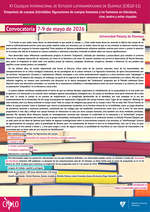CIELO
11th International Colloquium on Latin American Studies in Olomouc (CIELO-11)
Sympoiesis of (in)visible bodies: representations of human and non-human bodies in literature, film, theatre and the visual arts
May 7-9, 2026
"And the fact is that no one, until now, has determined what the body is capable of. (...) For no one has yet understood the structure of the body with sufficient precision to be able to explain all its functions, not to mention the fact that many things are observed in animals that far exceed human sagacity." These words by Spinoza probably pointed to possible ways of refocusing attention on the body beyond the human in new contexts and cultural relationships, inviting debate about its new meanings.
To develop these reflections, we consider the term “sympoiesis” to be appropriate, used by atomists and pre-Socratics to study the physical universe in its complex interaction of relationships, as well as in literature and the arts. In our context, we will draw on the observation of Donna Haraway, for whom sympoiesis is above all ‘a word for complex, dynamic, responsive, situated, and historical systems. It is a word that means “creating world together,” in company.’
In recent years, critical discourse has gained momentum in both the natural sciences and the humanities, challenging anthropocentrism in traditional ecological criticism, paradigms of human culture, and humanistic figuration. The terms ‘Anthropocene’ (Crutzen) and ‘Capitalocene’ (Malm) are frequently used, linked to a deeply negative view, as are other terms such as “solastalgia” and ‘extractivism.’ The aim of the colloquium, however, is not based on the urgent need to radically alter humanistic knowledge and culture. Rather than a negative reflection, in our case it would be more appropriate to discuss the conceptual framework of the ‘symbiocene’ proposed by environmental philosopher Glenn Albrecht as an alternative oriented towards an agreement of symbiotic coexistence or interdependence between human beings and their environment, as well as its ‘sympoietic’ expression in literature and other arts.
Our debate is greatly influenced by the fact that recent decades have seen the rehabilitation of corporeality in art, along with an openness to interaction and co-creation between multiple agents (technological, biological, etc.). The body manifests itself as an inherent part of the work of art. The return to the body is a process of subjectivation and the complicated apprehension of identity, even more complex in an era of questioning humanity. Hence the proposal to explore and figurate the human body as a ‘place of images’ (Belting). In this context, Jean-Luc Nancy understands the body as ‘a whole corpus of images that pass from one body to another.’ For her part, Meri Torras Francés refers to the human body ‘as the ghost that haunts Western thought, on the very border of its in/visibility, as a dynamic game of absent presences and present absences, constituted by the codes that enable us to recognise ourselves as other and with the other.’ At this point, we propose going further and reflecting on the human body in interaction not only with other human bodies, but also with other entities (animals, plants). For example, Brian Massumi, based on recent research that highlights creativity in nature and ‘artisticity,’ proposes rethinking the very nature of instinct and, thus, animality itself, restoring the human to the animal continuum.
The philosopher Vinciane Despret, for her part, draws on Spinoza's ideas to discuss some research on the physical approach to animals, “interphysiology” (the science of body agency), on the possibility of becoming, but ‘not exactly of becoming the other in metamorphosis, but with the other, not to feel what the other thinks or feels (...) but to welcome and create, in some way, the possibility of entering into a relationship of exchange and proximity that has nothing to do with a relationship of identification.’
Thematic areas for reflecting on the figurations of the body:
- Deformation and metamorphosis of bodies (of humans, animals, plants)
- Body and myth
- Body and performativity
- Bodies and extreme experiences
Information and registration
All papers related to the defined thematic areas are welcome. Those interested can submit their abstract via the registration form (maximum 300 words). Presentations will last 20 minutes.
The deadline for submitting proposals is 15 February 2026.
The deadline for communicating the acceptance of proposals will be 1 March 2026.
Working languages: Spanish and Portuguese.
Registration fee: €180 (€120 for doctoral students).
Organising committee: Daniel Nemrava, Zuzana Jurajdová, Markéta Riebová, Jakub Hromada, Zuzana Burianová, Diego Samuelle Guillén.
Email: cielo@upol.cz
Transport and Accomodation
Transport to the city of Olomouc
There are several ways to get to the city of Olomouc from the nearest airports: Bratislava, Brno, Ostrava, Prague, and Vienna. Below is information on how to get there.
From Prague
Take the Airport Express bus from the stop in front of Terminal 1 to the central railway station, which is the final stop. The railway companies offering connections to Olomouc are Česke dráhy, Leo Express and Student Agency. The journey takes approximately two and a half hours.
From Vienna
The aforementioned Student Agency offers daily bus connections to the city of Olomouc (with a transfer in Brno). The Tiger Express company connects Vienna Airport with the city of Olomouc daily. The journey takes approximately three and a half hours.
Accommodation
Participants in the event can stay at the General Svobody university residence. We recommend booking as soon as possible, as room availability is limited. To make a reservation, please contact the reception desk (in English): hotel@upol.com.
We also recommend the following options:
